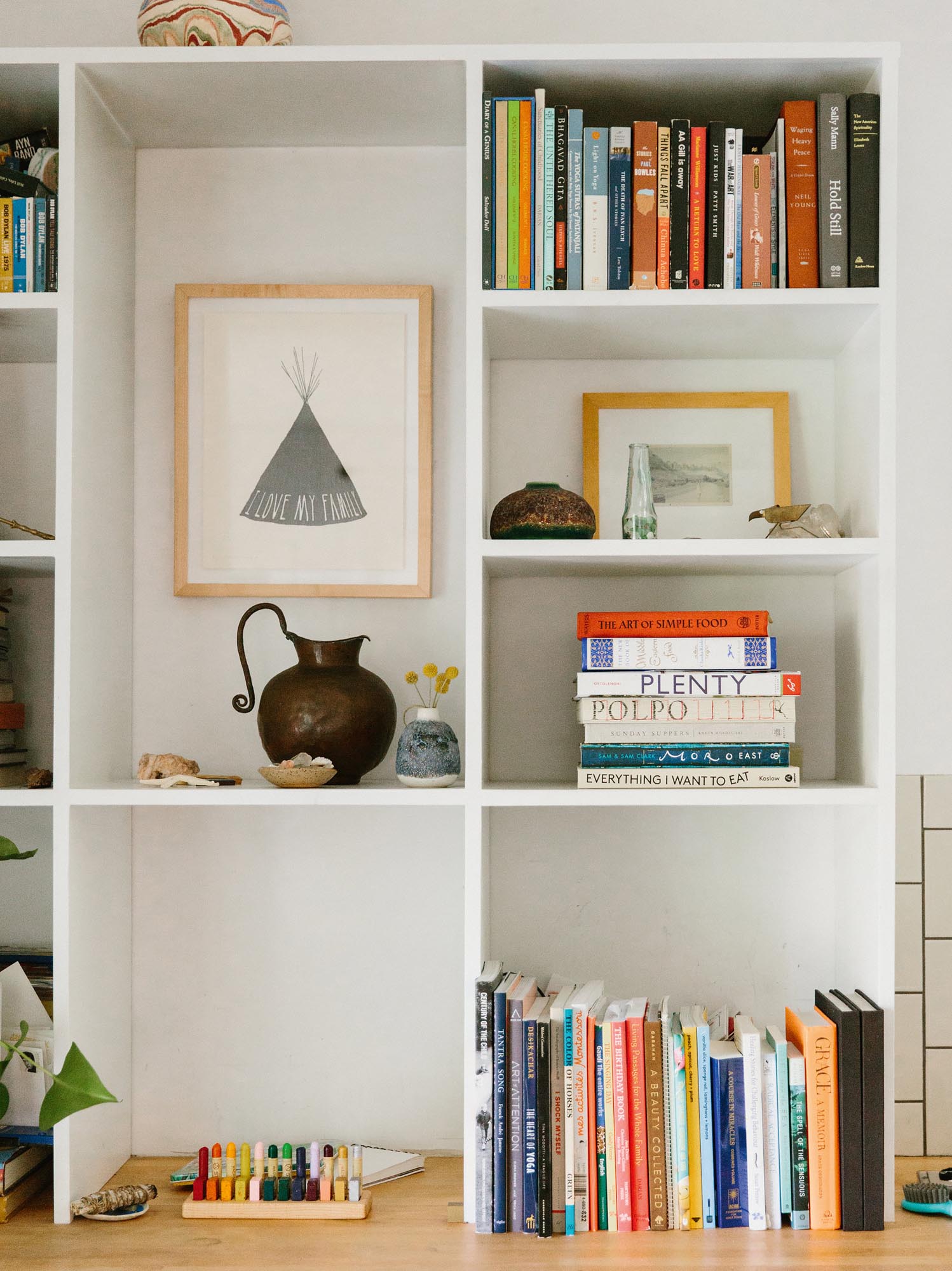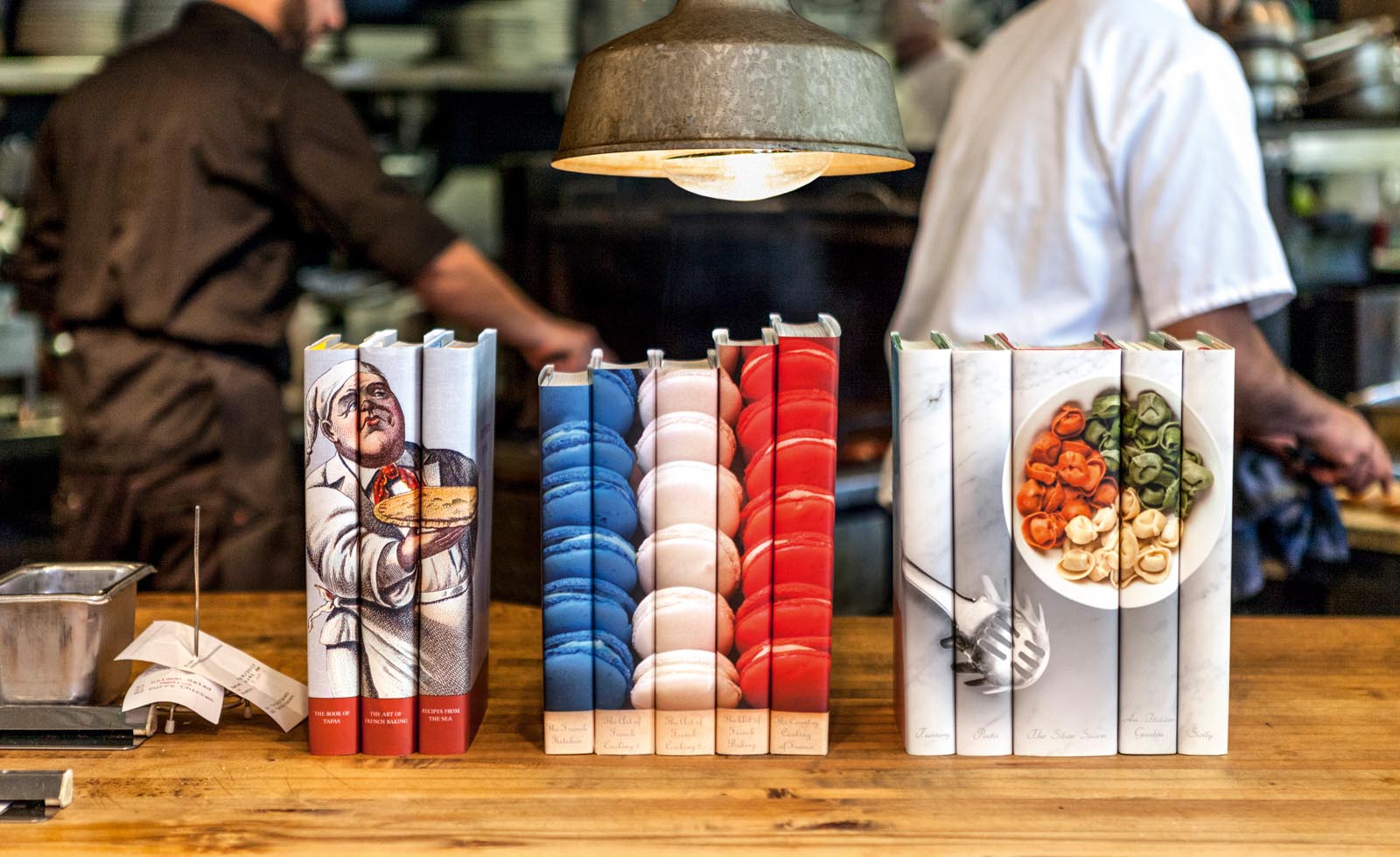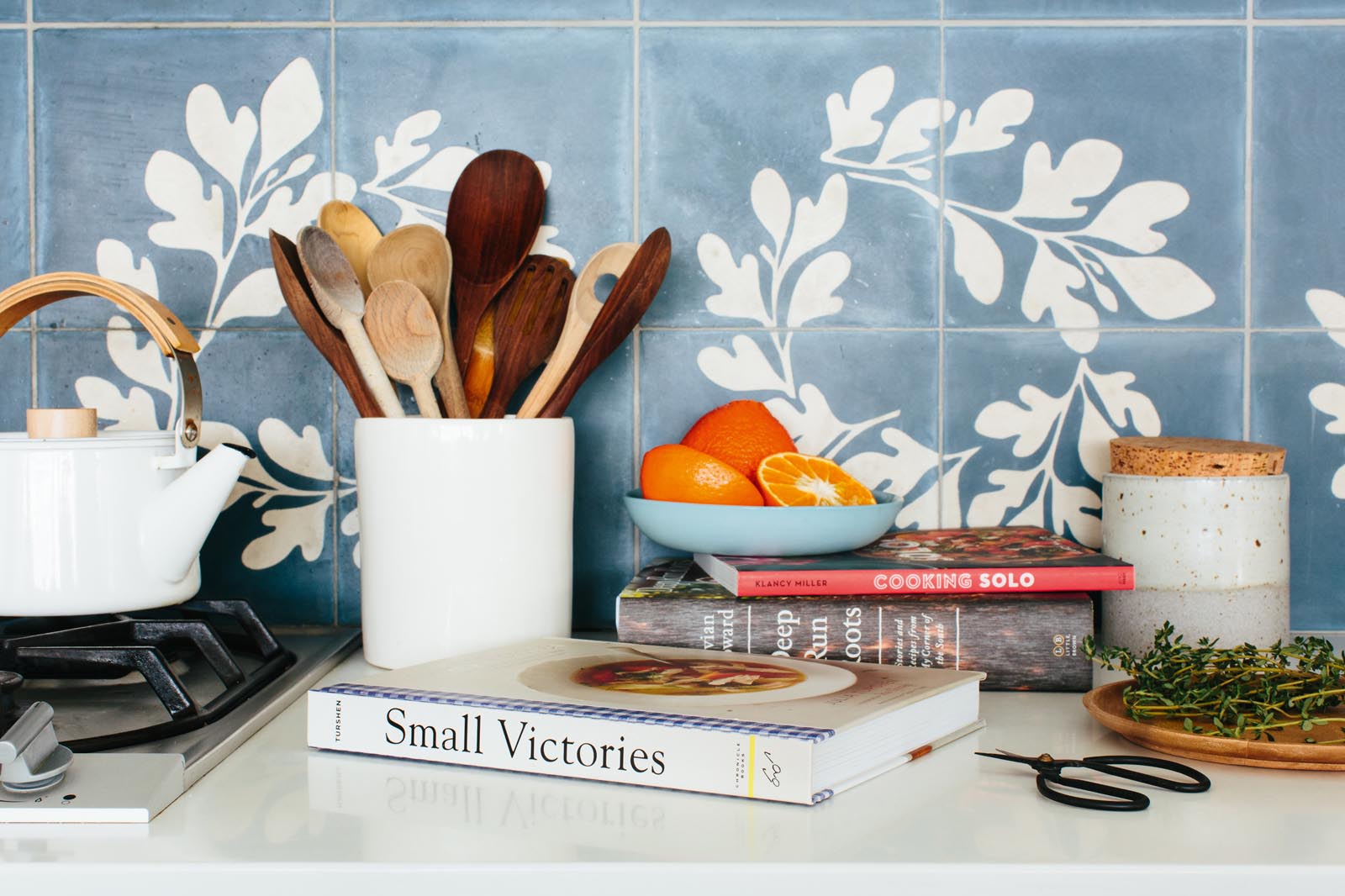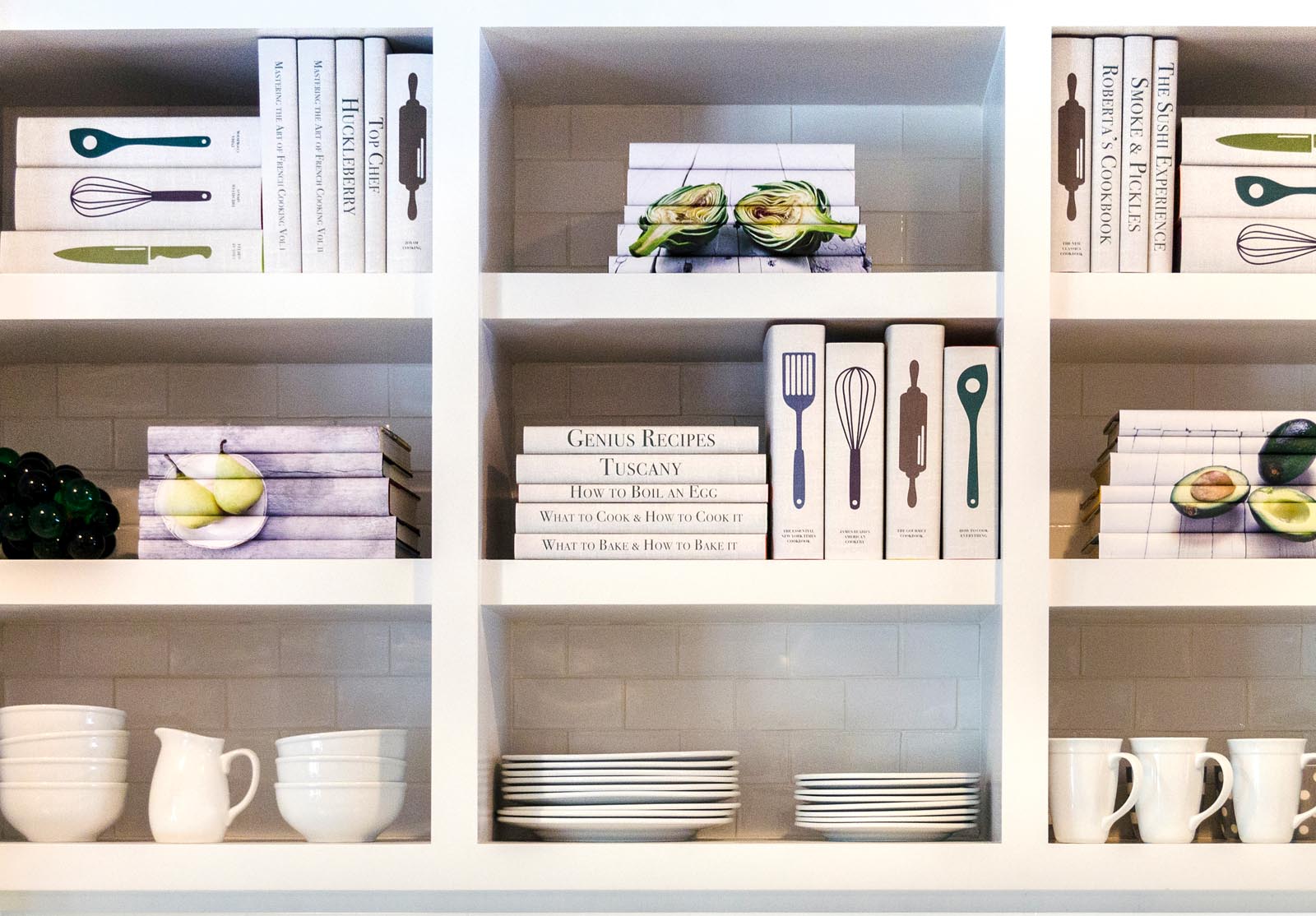
Do books in the kitchen really require a separate chapter? Don’t you just put the cookbooks on the counter and then you’re done?
Yes, but . . .
As with all the books in your home, there are benefits to bringing a little more thought and complexity to this area.
The kitchen is often the living, breathing heart of the home—the place to create, connect, and gather. It is this room in which we often spend the most time and the one which holds the most memories.
Anyone who’s ever hosted a party knows that guests love to crowd in the kitchen. It becomes the living room when you’re entertaining, so why not bring books in and have a little fun? Take the books beyond the instructional reference books just for cooking.

Credit: Nicki Sebastian. Features the home of Elizabeth Antonia.
The books in Elizabeth’s kitchen follow the theme of food, yet the genres extend beyond cookbooks to include fiction, memoir, poetry, and children’s books—anything with a connection to food or dining. This creates a space that is unique, one that tells her own story alongside the family’s story. This type of complexity adds more to what makes a kitchen great—conversations held within a space that reflects who we are and expands connections with our friends.
Requests for Juniper Books to create something different with books in the kitchen don’t come every day, but when they do, we try to work closely with clients to maximize the opportunity to be unconventional. Perhaps it’s related to Thatcher’s father, Barry Wine, and his unconventional career in the kitchen!
Barry graduated from the University of Chicago Law School in the 1960s, practiced law on Wall Street, then moved upstate New York, and later opened a restaurant as a side venture. He went on to become one of the most innovative and celebrated chefs in New York City, overseeing The Quilted Giraffe. The lack of formal culinary training or being bound to a particular tradition allowed him to come up with new ideas for the restaurant including dishes such as the Raw Tuna Wasabi Ricotta Pizza (still served at The Mercer Kitchen in New York).


Credit: Danlly Domingo.

Food and books are two incredibly important things in our lives that can be sourced from all over, remixed into infinite combinations, and presented in ways no one thought possible. A few decades ago, perhaps most people thought that dinner was dinner. Now there are entire TV networks, magazines, blogs, and more, constantly creating and repackaging dinner as we know it!
The same goes for books—they have not experienced quite the same media revolution as food, but they hold the potential to yield as much or more delight and entertainment in our homes. If we open up the possibility of play with our books, we can have a lot of fun and learn more about ourselves and the world.
Cookbooks are one of the most used books in the house—constantly pulled off the shelf, thumbed through, dog-eared, and spilled on. They are the workhorse books, wearing the evidence of their use on their covers and pages. Historically, these books were mostly information and text.
Think of your family’s well-loved copy of Joy of Cooking or Cook’s Illustrated; or books by Julia Child and James Beard. These books were and still are the cornerstones of many kitchen cookbook collections.
Recently, though, there has been a shift as cookbooks have become art books in their own right, lavishly illustrated with elaborate covers, beautiful food styling, and photography. Just like books of a variety of genres might find their home on the kitchen shelves, a cookbook can now live beyond the kitchen counter, moving to the dining room or even your living room.
Elizabeth has a few cookbooks piled on her bedside table, in her living room and dining room, and all throughout the house really. In her mind, cookbooks belong everywhere. And yet, even with these design upgrades and genre-bends, the way we use our cookbooks is essentially the same. These books yearn to be used.
Thatcher’s kitchen library contains a variety of cookbooks from Jewish to gluten-free to the healthy recipes that got him and his family through cancer treatment in 2017. The books from this period, when Thatcher was mostly unable to cook while going through chemotherapy, have additional meaning to him post-cancer. The books symbolize a time in life that was difficult; keeping the cookbooks that helped him get through that time is part of his story.




For many families, the books in the kitchen tell the story of family history through various cuisines. When Juniper Books curates cookbooks for a family, we ask about the family history and their culinary preferences, trying to get a sense for how they will interact and be inspired by the books.
Some clients have a collection of cookbooks they own and love, and they can send them to Juniper Books to have them wrapped in a design that unites the books while enhancing the decorative aspects of the kitchen. A nice clean look for the jackets keeps the books white with the titles revealed as a subtle decorative element on the spine, complementing the neutral tones of the space while also making sure the books are easy to access and reference.
Look at your kitchen with the fresh eyes of an artist—seeing both the space and the negative space. Within each there are endless possibilities.
The shelf at the bottom of your bar cart? A perfect spot for books! The corner of your countertop? More books! That mortar and pestle you thought you would use more, but haven’t? A bookend! That odd space between your cabinets and the ceiling? Line it with books!
Your favorite foodie fiction will fit easily alongside the Michael Pollan classics, and Tomie dePaola’s Strega Nona is a natural fit alongside Russel Hoban’s Bread and Jam for Frances and Elaine Dundy’s The Dud Avocado. The point is, within this space freedom reigns. There are few rules, so let’s have some fun!
Bend the rules, play, stack the books high in the usual (or unusual) places, extend the boundaries, and fall in love—with food, with conversation, and community; with the space; and most importantly, with the books that bring it all together.





 Keep your most used cookbooks on the lower shelves, stored vertically so that they are easily within reach.
Keep your most used cookbooks on the lower shelves, stored vertically so that they are easily within reach.
 Turn the spice rack into cookbook storage with a face out display.
Turn the spice rack into cookbook storage with a face out display.
 Use a vintage milk crate to store cookbooks on the countertop or a vintage dish rack for kitsch appeal.
Use a vintage milk crate to store cookbooks on the countertop or a vintage dish rack for kitsch appeal.
 Store books beneath the kitchen island.
Store books beneath the kitchen island.
 Utilize just about anything to serve as a bookend, even a favorite bottle of olive oil.
Utilize just about anything to serve as a bookend, even a favorite bottle of olive oil.
 Use the empty space above the refrigerator or above the cabinets for more books.
Use the empty space above the refrigerator or above the cabinets for more books.

Credit: Christine Han.

Credit: Christine Han. Features the home of Jeanine Hays and Bryan Mason.